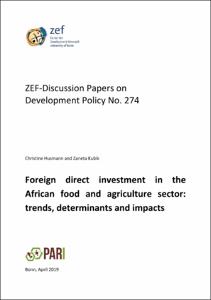Husmann, Christine; Kubik, Zaneta: Foreign direct investment in the African food and agriculture sector: trends, determinants and impacts. Bonn: Center for Development Research (ZEF), 2019. In: ZEF Discussion Papers on Development Policy, No. 274.
Online-Ausgabe in bonndoc: https://hdl.handle.net/20.500.11811/9628
Online-Ausgabe in bonndoc: https://hdl.handle.net/20.500.11811/9628
@techreport{handle:20.500.11811/9628,
author = {{Christine Husmann} and {Zaneta Kubik}},
title = {Foreign direct investment in the African food and agriculture sector: trends, determinants and impacts},
publisher = {Center for Development Research (ZEF)},
year = 2019,
month = apr,
series = {ZEF Discussion Papers on Development Policy},
volume = No. 274,
note = {In this paper, we seek to answer three research questions: (1) What is the pattern of foreign direct investment (FDI) in the African food and agriculture sector in the last 15 years? (2) What are the drivers of FDI in the African food and agriculture sector? (3) What is the evidence on the impacts of private-sector investments in the African food and agriculture sector on the product and labor markets, with particular focus on income effects? Our analysis shows that a total of $48.737 billion was invested in the African food and agriculture sector by foreign private-sector investors between 2003 and 2017, with a noticeable peak in FDI inflows observed after the 2008/09 agricultural commodities shocks suggesting that international investors want to capitalize on high food prices. The initiatives such as the New Alliance for Food Security and Nutrition and Grow Africa, which aim to create a conducive environment for investment, might have also contributed to the growth of FDI volumes reported over the last years.
Our econometric analysis reveals that market potential is one of the main drivers of FDI in food and agriculture sector in Africa. More specifically, population size consistently has a significant impact on sectoral FDI inflows in Africa, irrespective of the model specification. Among the supply-side factors, the size of agricultural land turns out to be an important predictor of FDI inflows. Agglomeration effects are also observed, with a lagged volume of FDI inflows having a very strong impact on the level of current FDI. Finally, infrastructure or institutional quality play an essential role in attracting investment. These findings give support to various strands of literature that we drew upon in the theoretical framework.
Uncovering the impacts that private-sector investment has on the population proved not to be straightforward. Even though the literature is relatively abundant, it is flawed with multiple methodological issues that limit its internal and external validity. Despite these caveats, most of the studies reviewed in our paper seem to suggest positive impacts on farm and labor income. The effects on equality and poverty are not clear, as some investment schemes may be biased towards the better-off households. However, wage-employment opportunities generated by private-sector investment seem to benefit the poorest, especially when they target unskilled labor or women. Finally, there is evidence that private-sector investment might act as a driver of technical innovation. However, many research gaps remain},
url = {https://hdl.handle.net/20.500.11811/9628}
}
author = {{Christine Husmann} and {Zaneta Kubik}},
title = {Foreign direct investment in the African food and agriculture sector: trends, determinants and impacts},
publisher = {Center for Development Research (ZEF)},
year = 2019,
month = apr,
series = {ZEF Discussion Papers on Development Policy},
volume = No. 274,
note = {In this paper, we seek to answer three research questions: (1) What is the pattern of foreign direct investment (FDI) in the African food and agriculture sector in the last 15 years? (2) What are the drivers of FDI in the African food and agriculture sector? (3) What is the evidence on the impacts of private-sector investments in the African food and agriculture sector on the product and labor markets, with particular focus on income effects? Our analysis shows that a total of $48.737 billion was invested in the African food and agriculture sector by foreign private-sector investors between 2003 and 2017, with a noticeable peak in FDI inflows observed after the 2008/09 agricultural commodities shocks suggesting that international investors want to capitalize on high food prices. The initiatives such as the New Alliance for Food Security and Nutrition and Grow Africa, which aim to create a conducive environment for investment, might have also contributed to the growth of FDI volumes reported over the last years.
Our econometric analysis reveals that market potential is one of the main drivers of FDI in food and agriculture sector in Africa. More specifically, population size consistently has a significant impact on sectoral FDI inflows in Africa, irrespective of the model specification. Among the supply-side factors, the size of agricultural land turns out to be an important predictor of FDI inflows. Agglomeration effects are also observed, with a lagged volume of FDI inflows having a very strong impact on the level of current FDI. Finally, infrastructure or institutional quality play an essential role in attracting investment. These findings give support to various strands of literature that we drew upon in the theoretical framework.
Uncovering the impacts that private-sector investment has on the population proved not to be straightforward. Even though the literature is relatively abundant, it is flawed with multiple methodological issues that limit its internal and external validity. Despite these caveats, most of the studies reviewed in our paper seem to suggest positive impacts on farm and labor income. The effects on equality and poverty are not clear, as some investment schemes may be biased towards the better-off households. However, wage-employment opportunities generated by private-sector investment seem to benefit the poorest, especially when they target unskilled labor or women. Finally, there is evidence that private-sector investment might act as a driver of technical innovation. However, many research gaps remain},
url = {https://hdl.handle.net/20.500.11811/9628}
}






